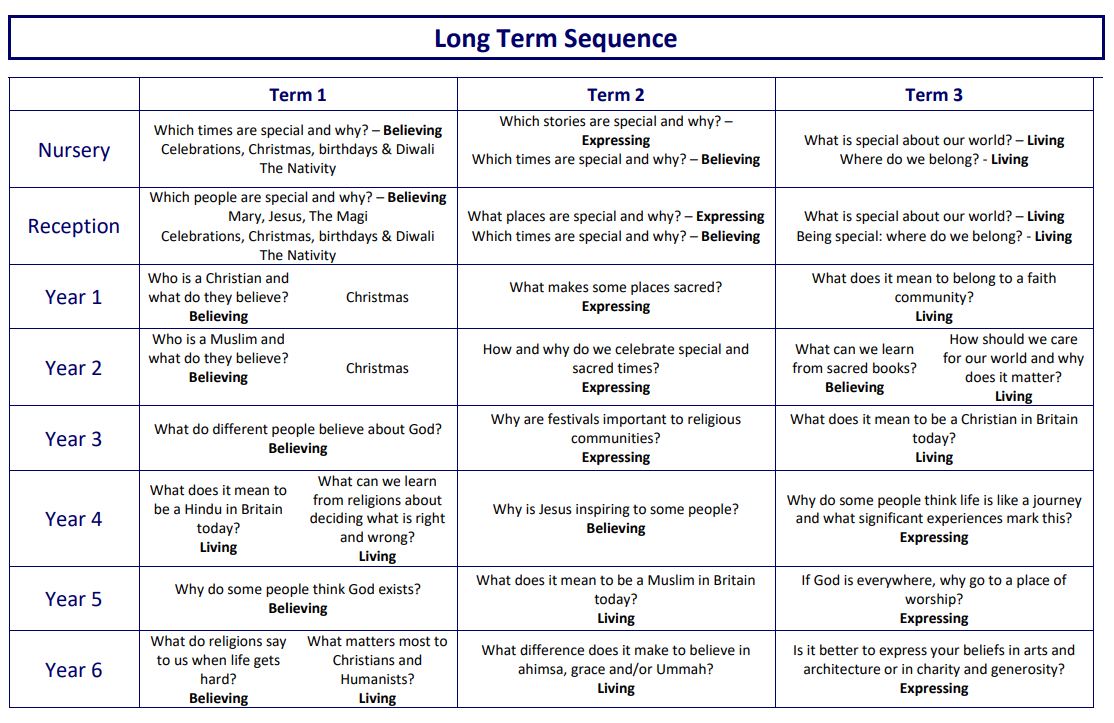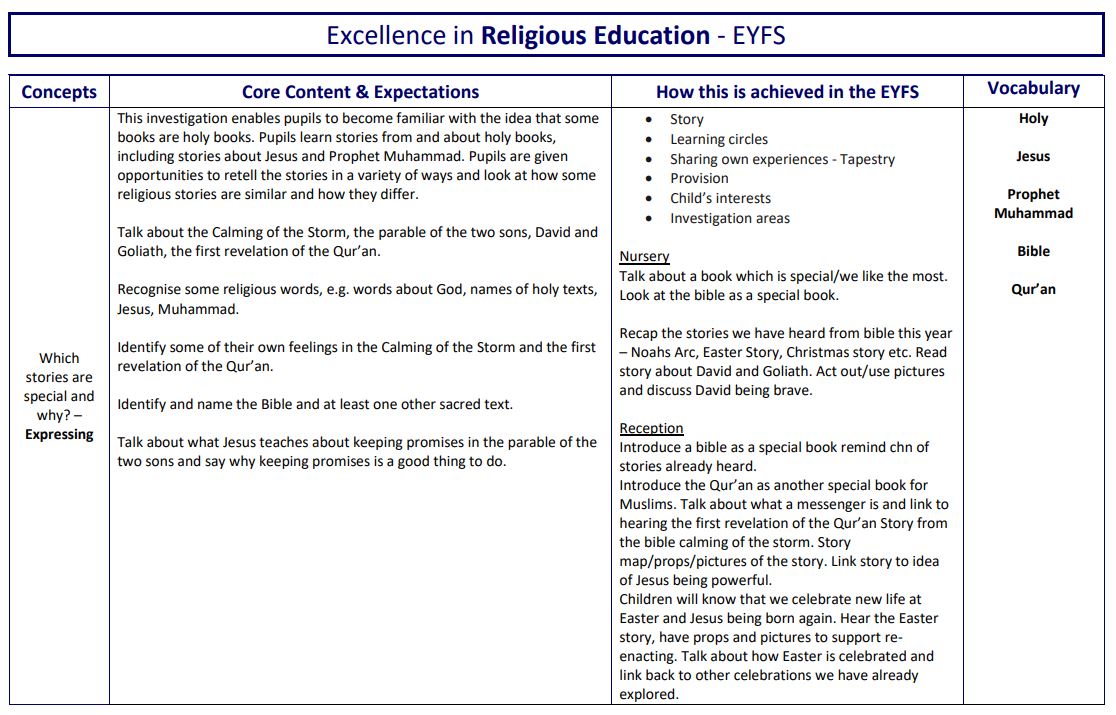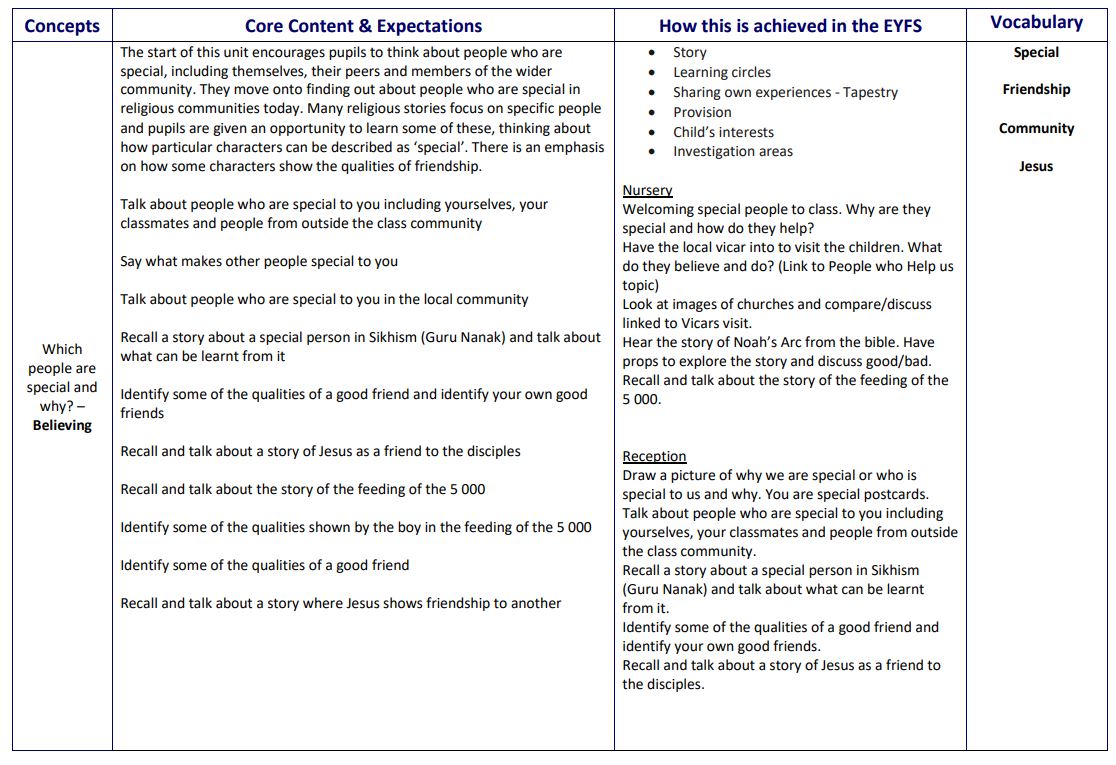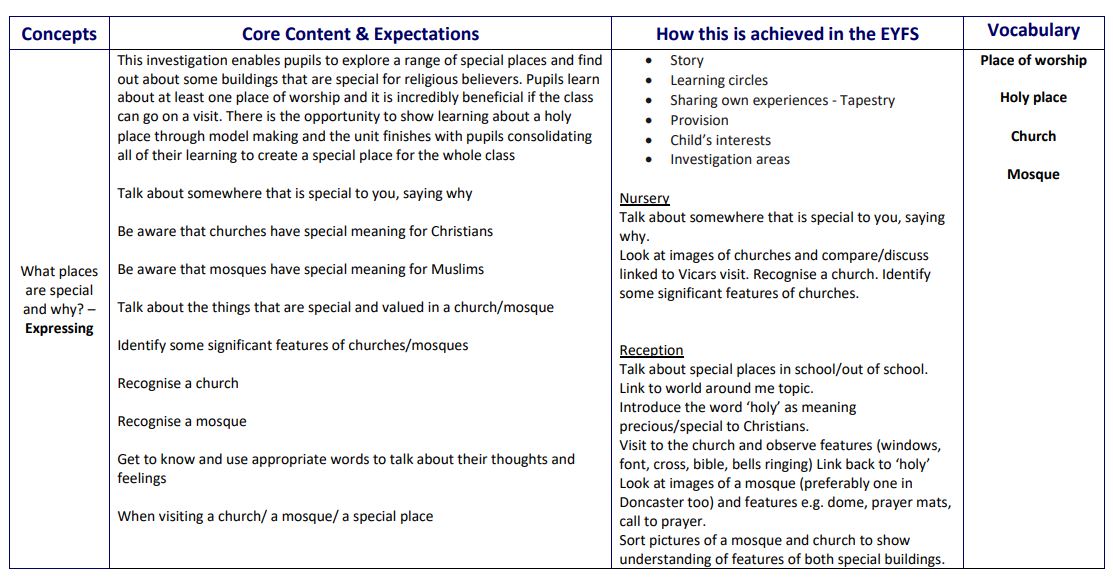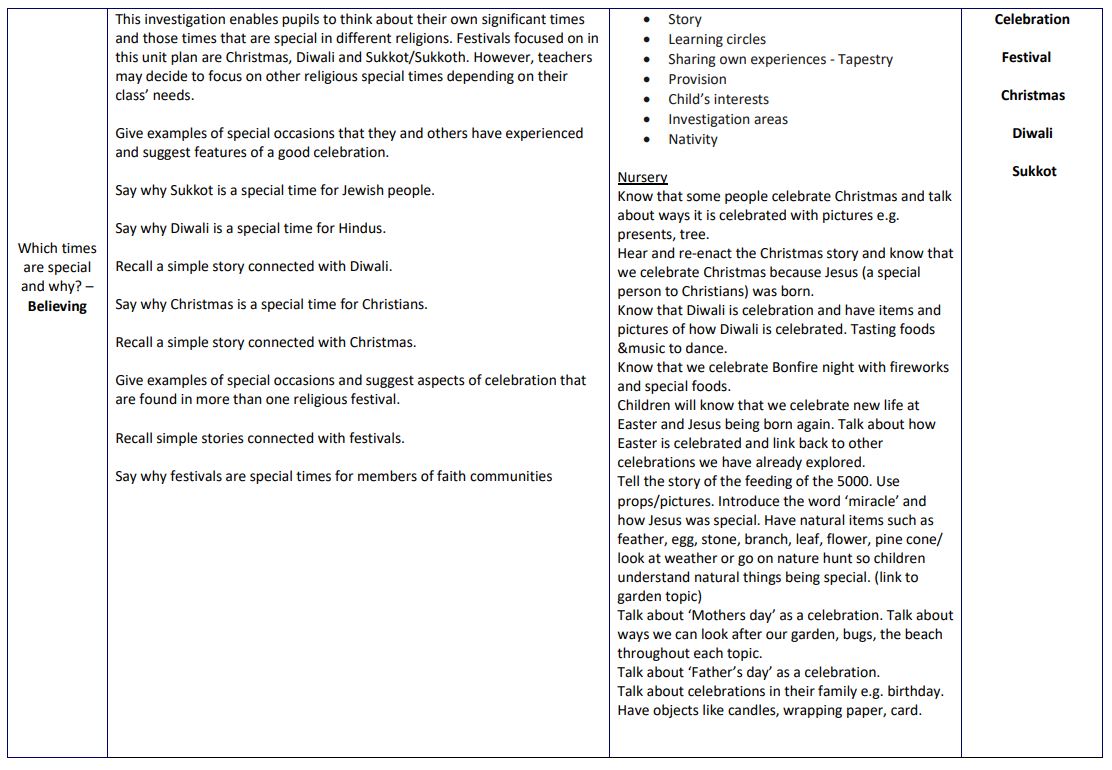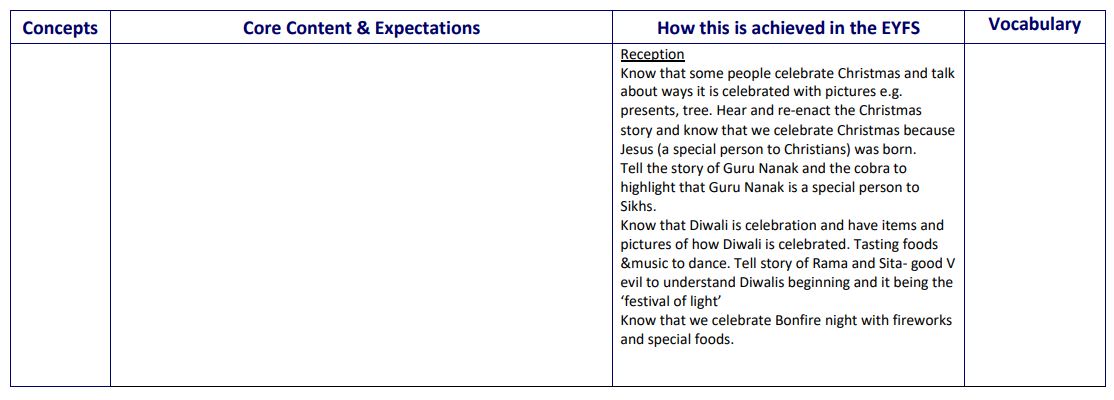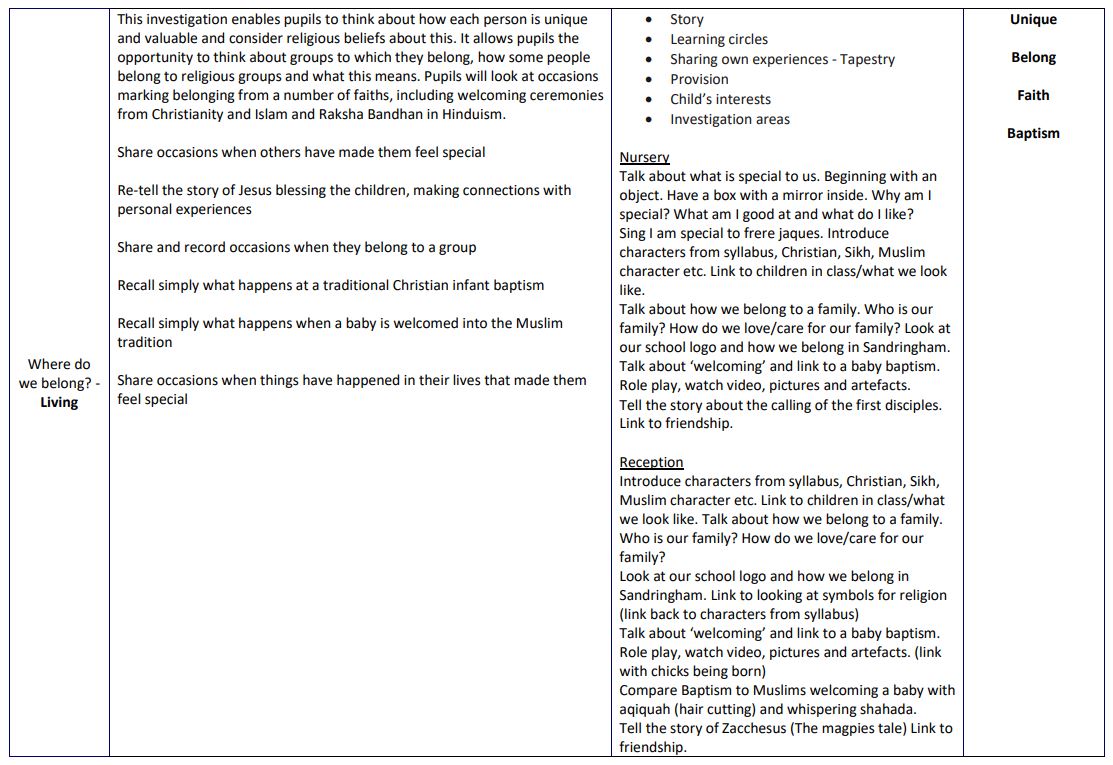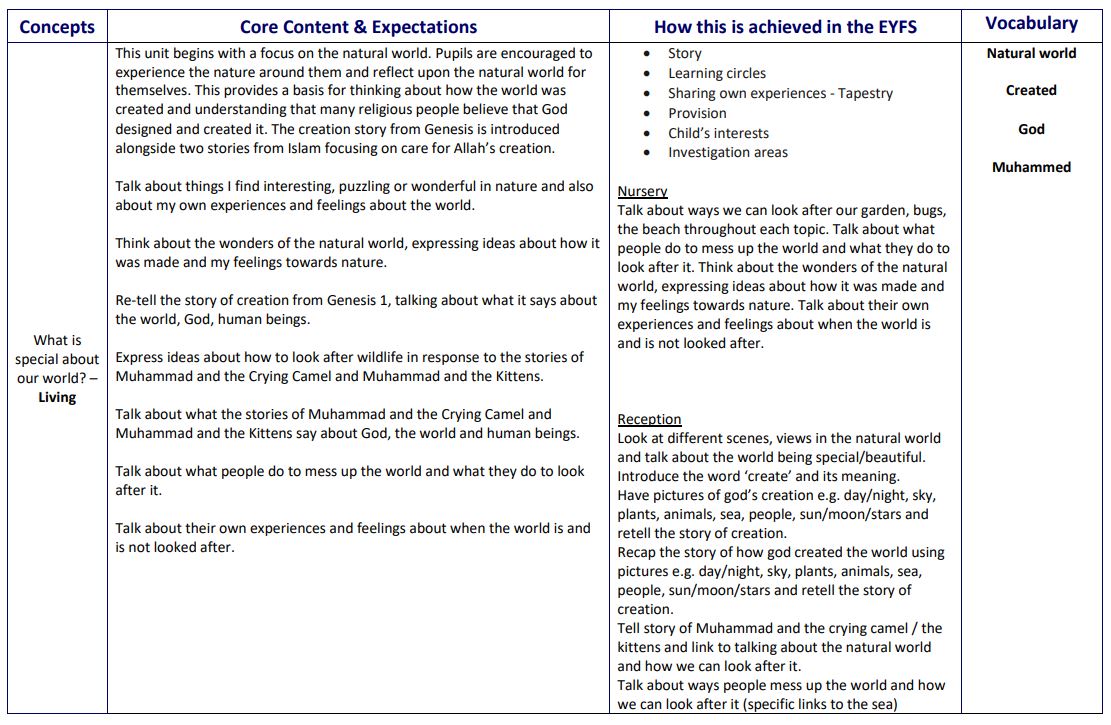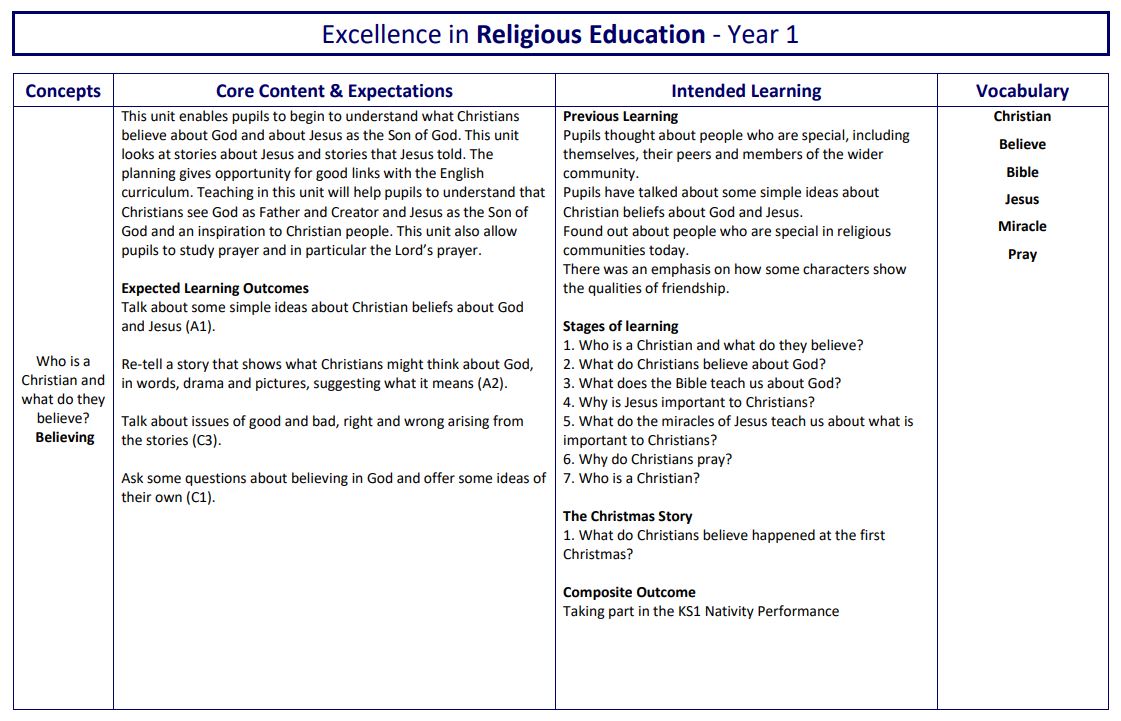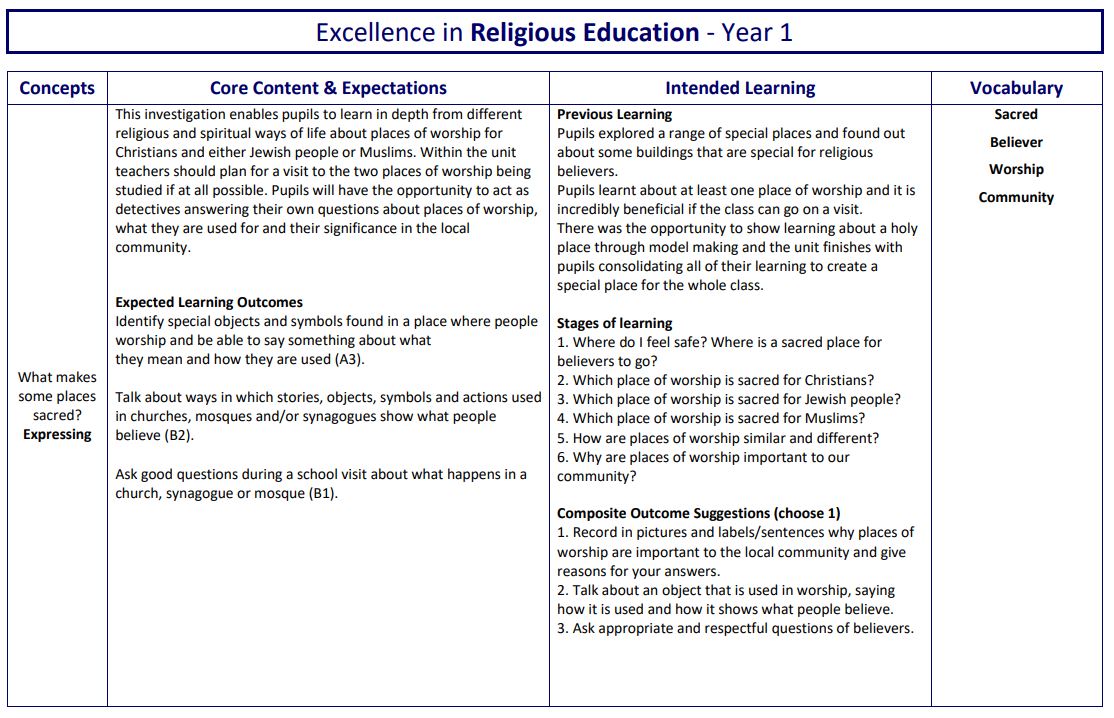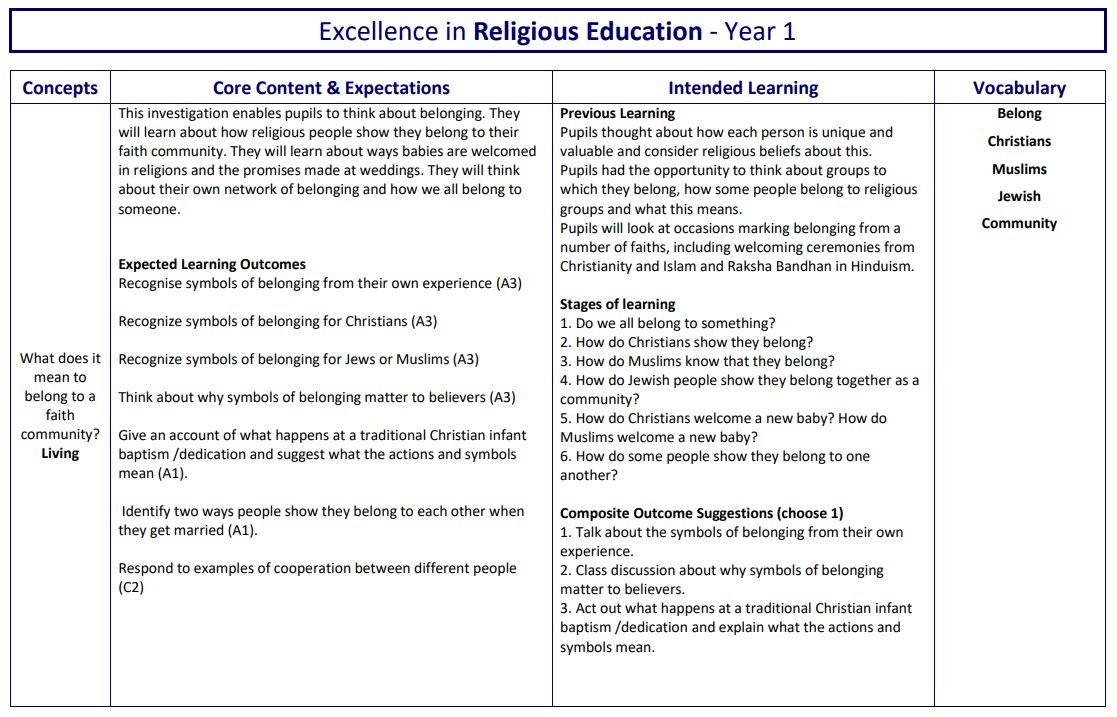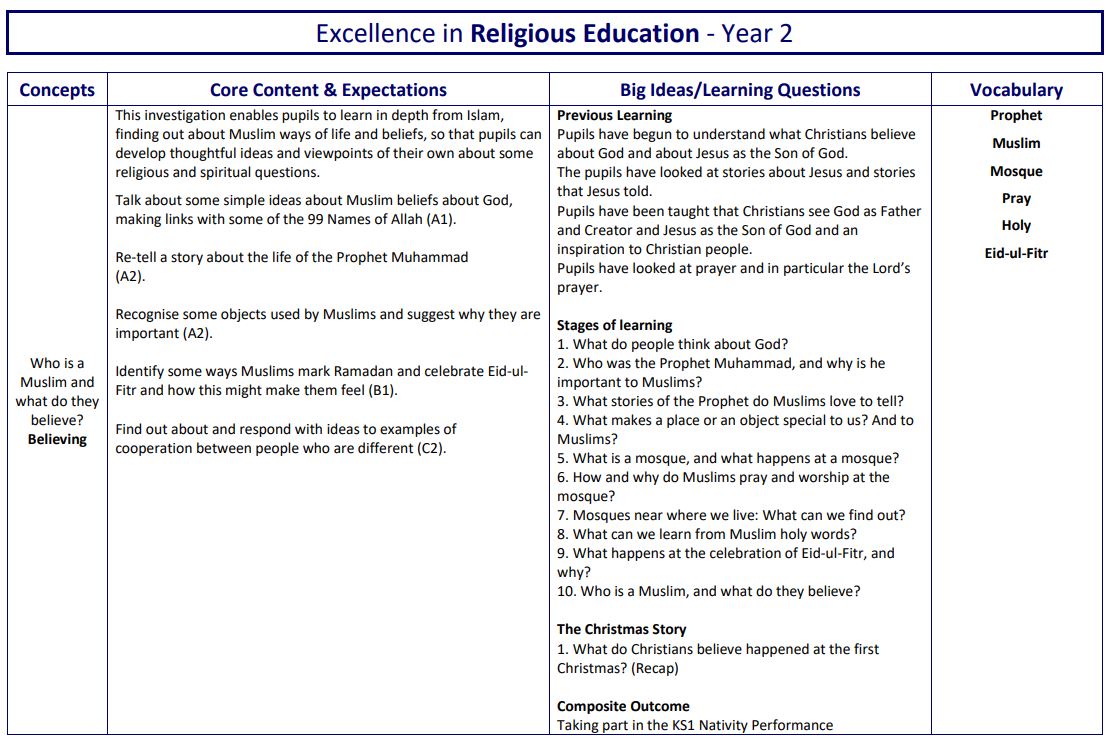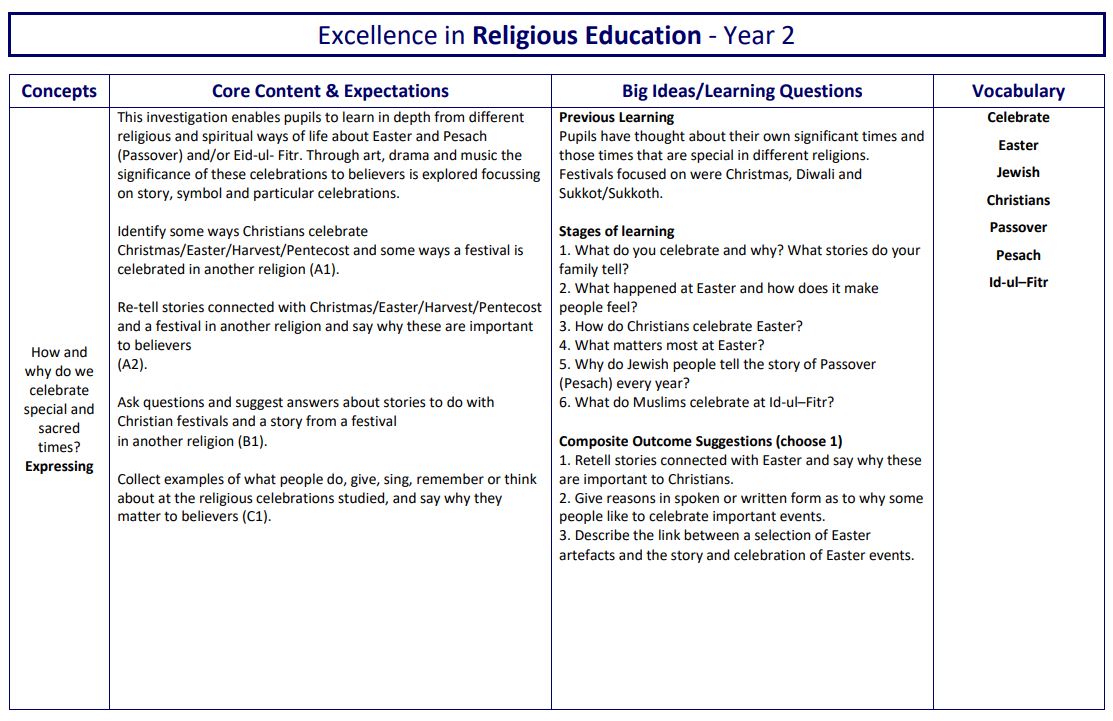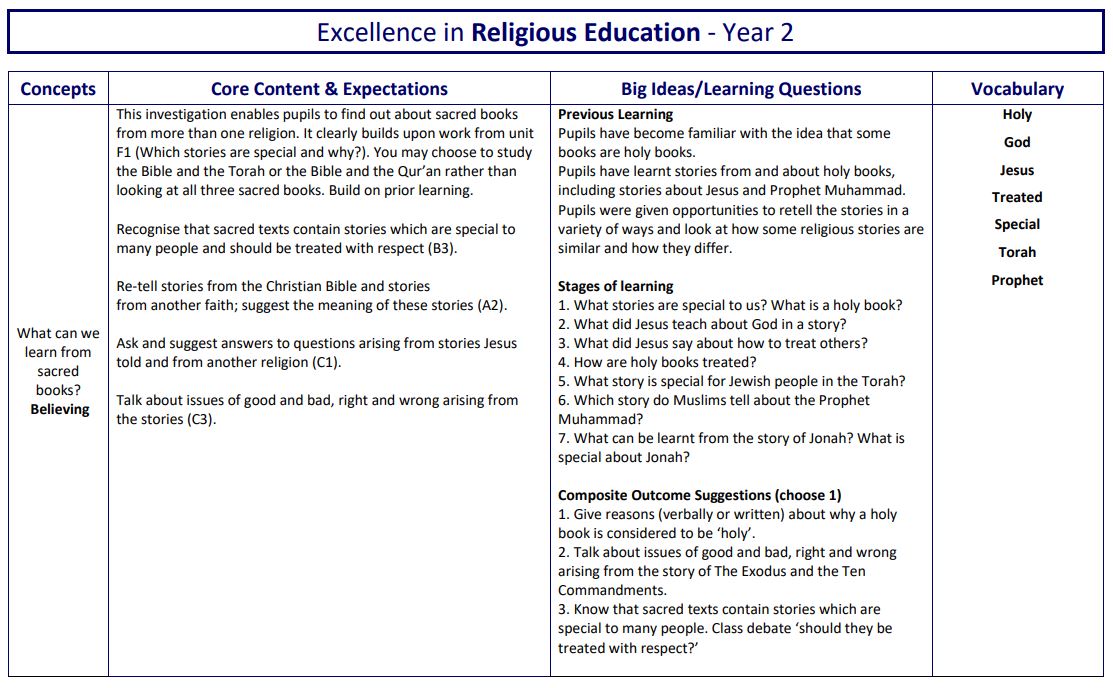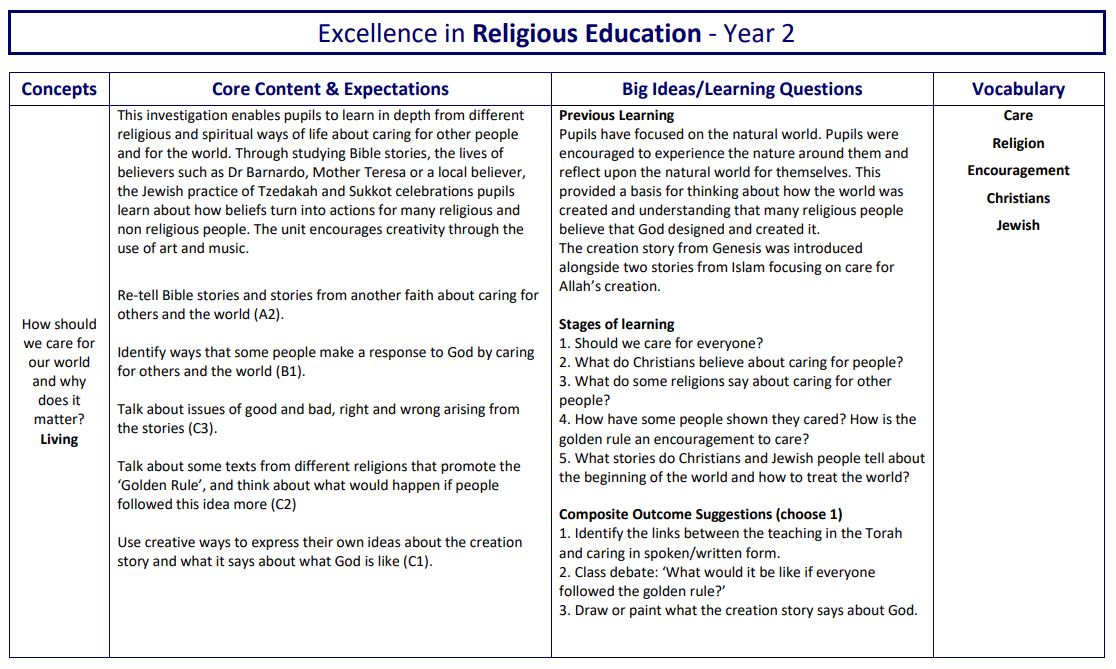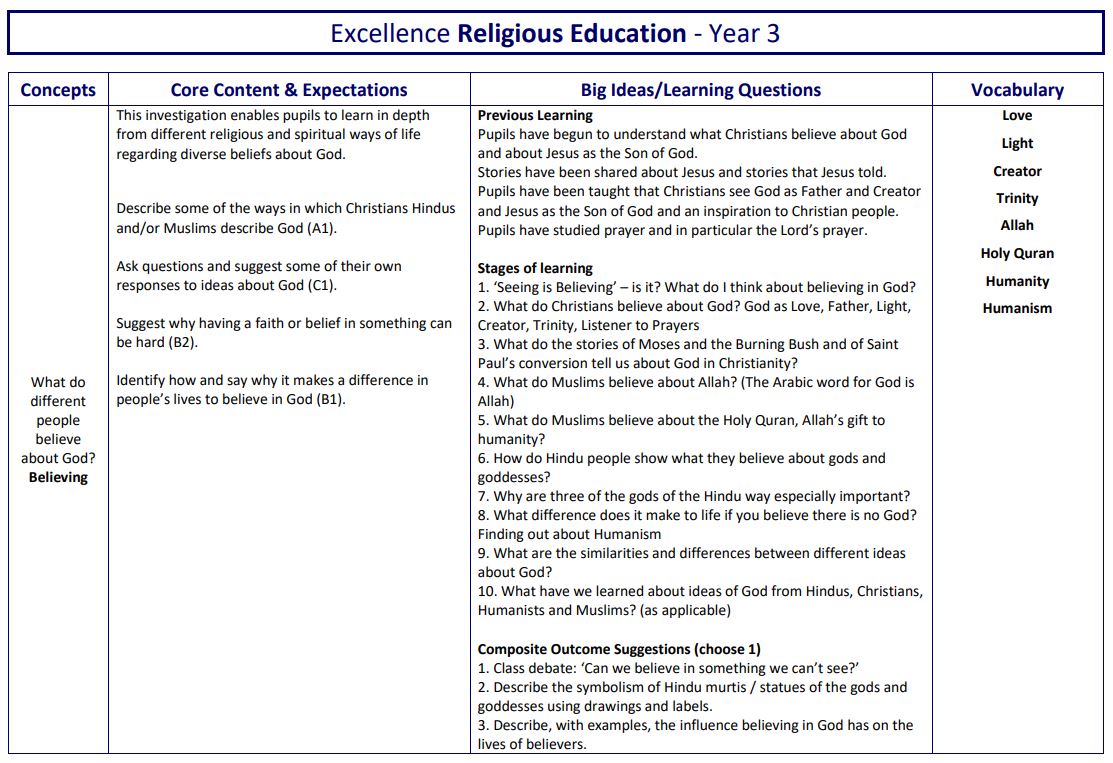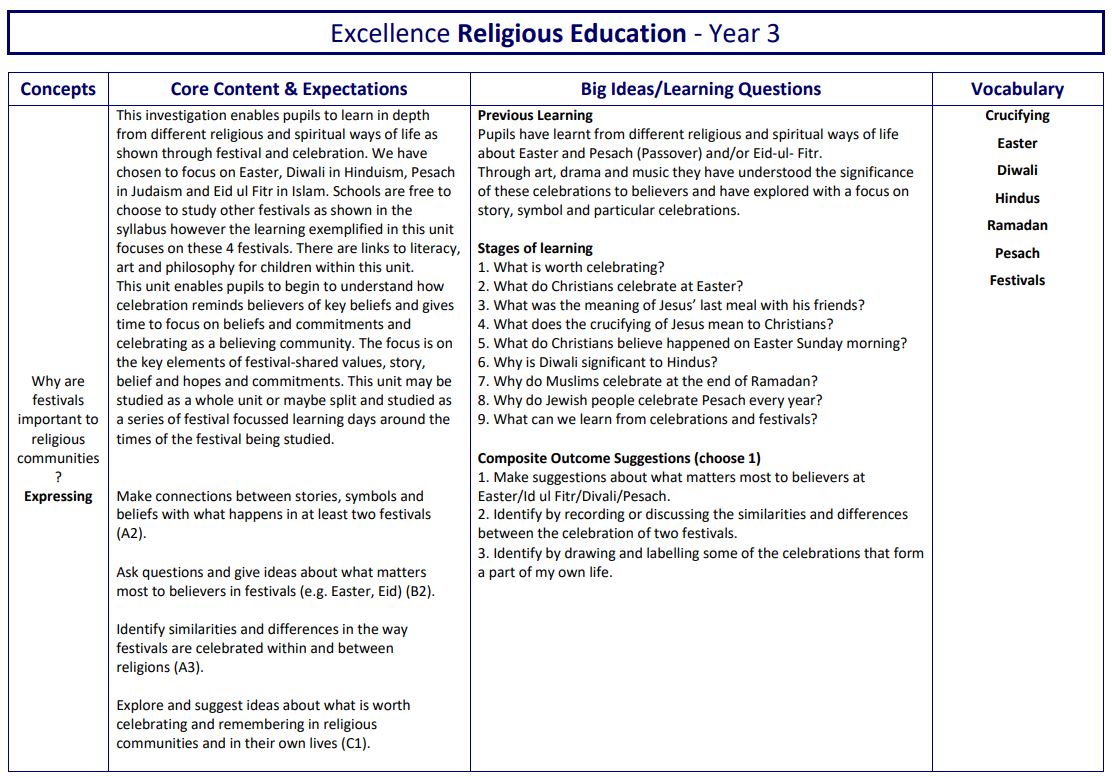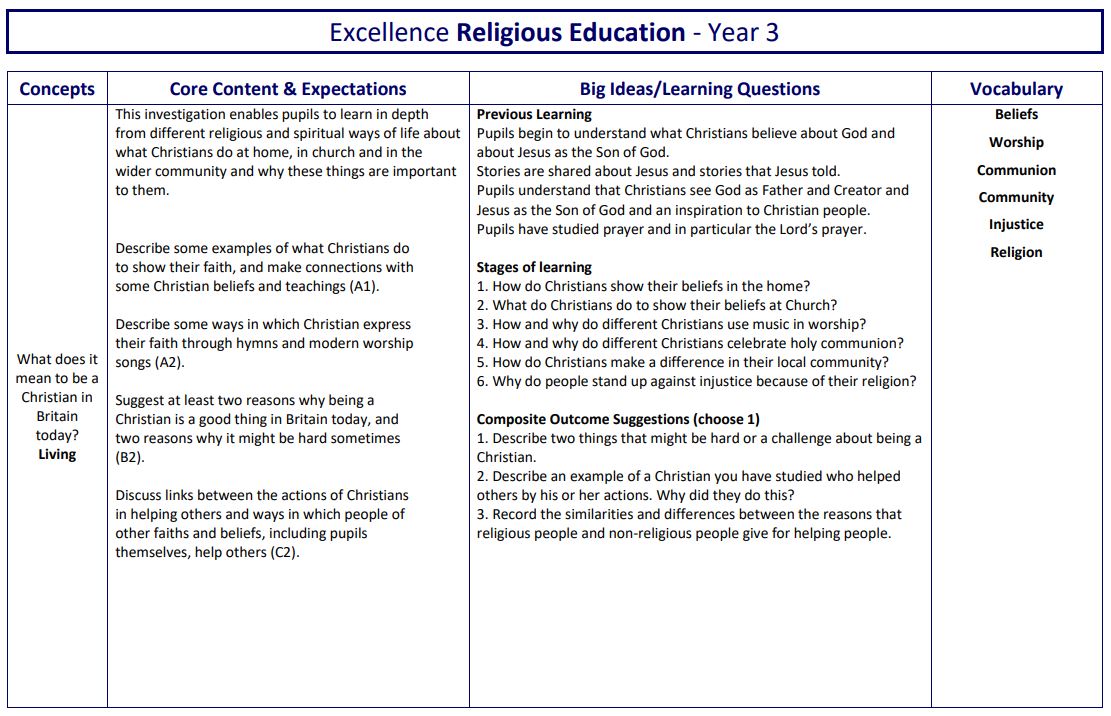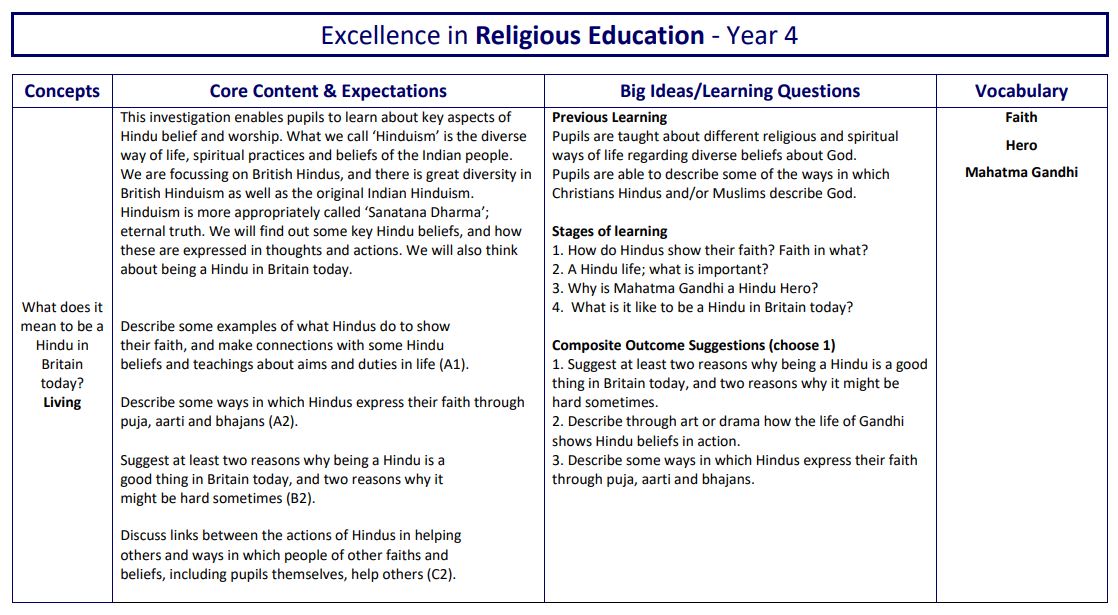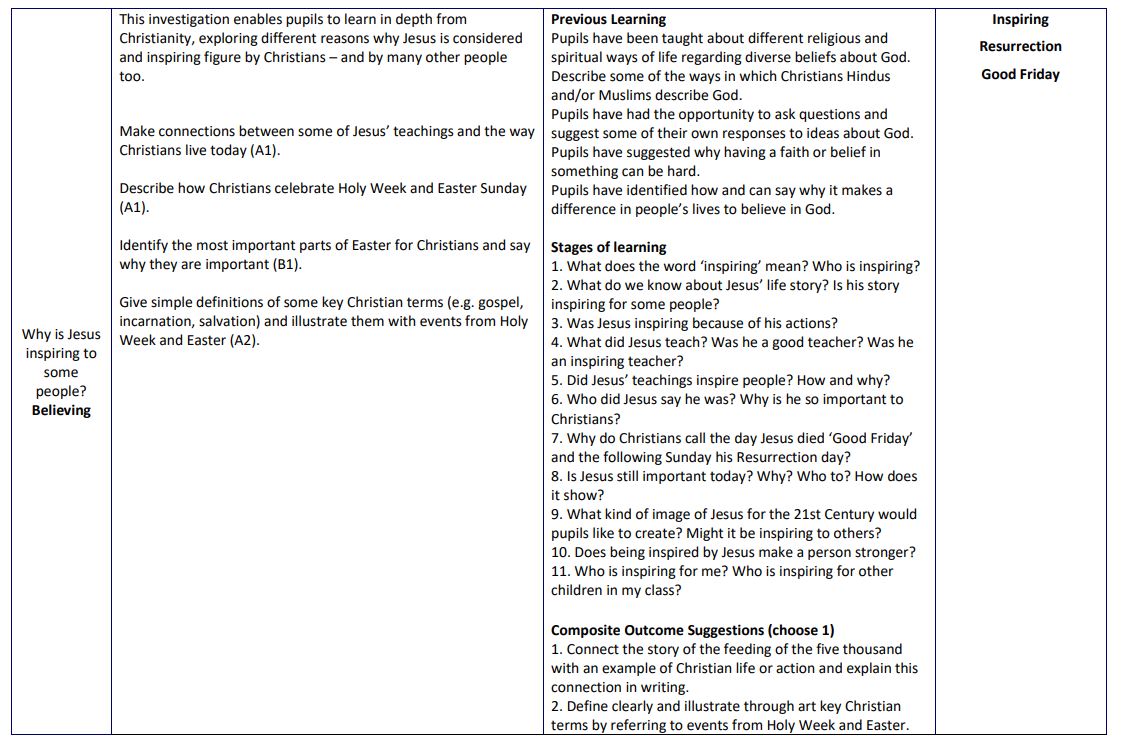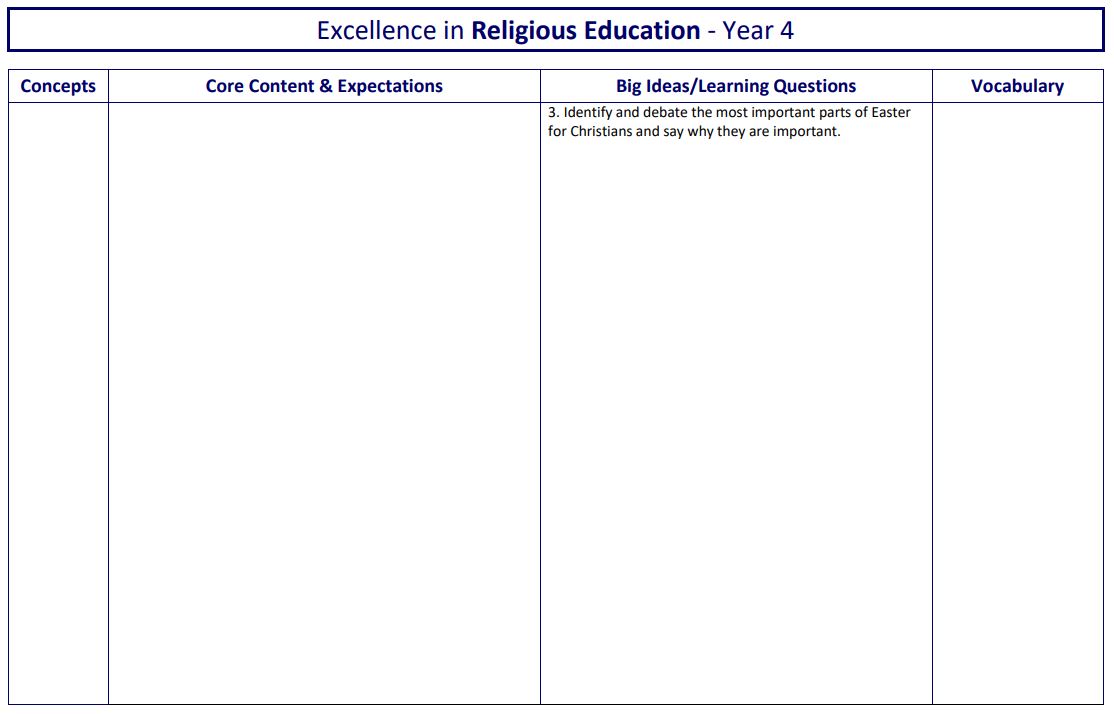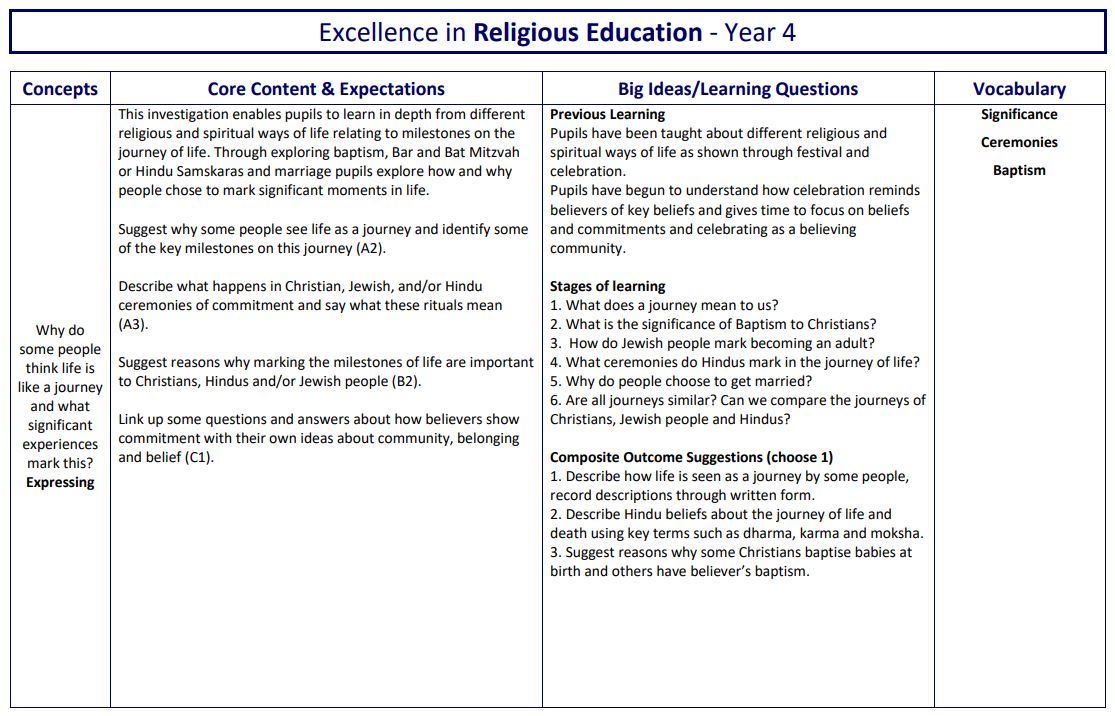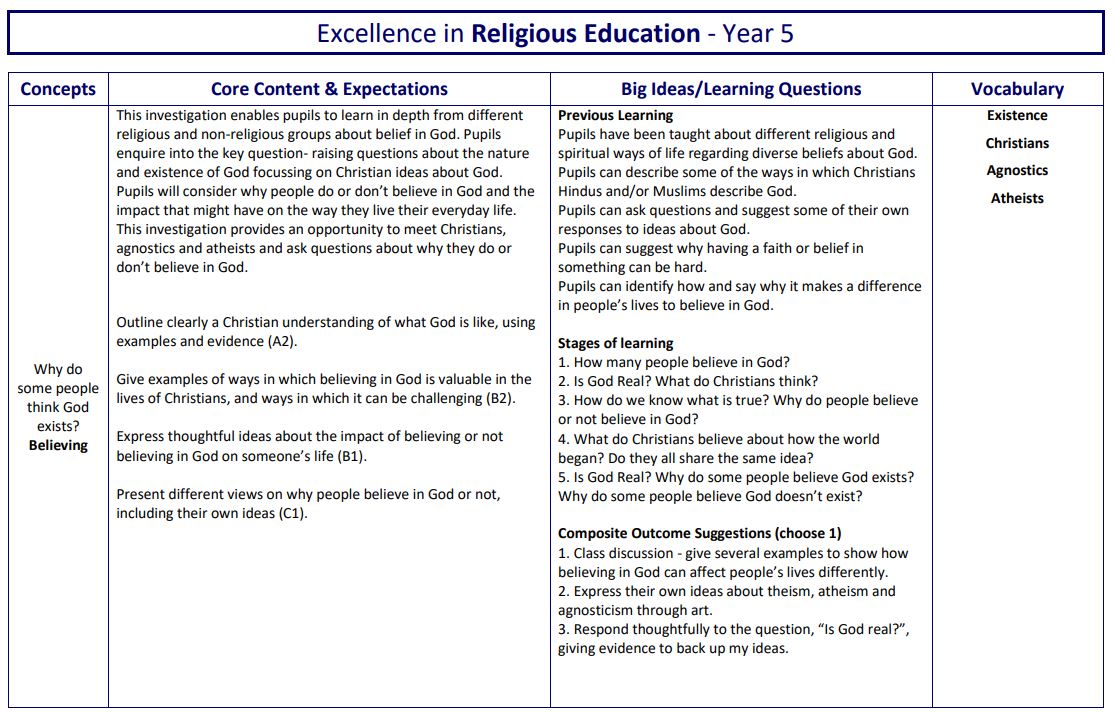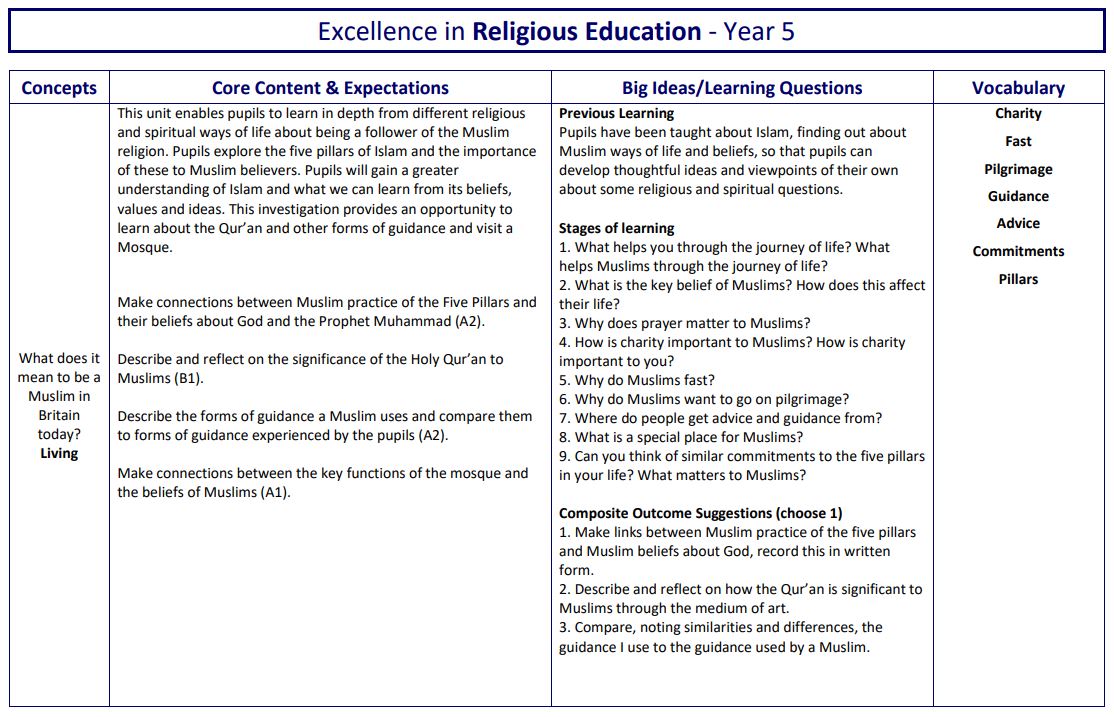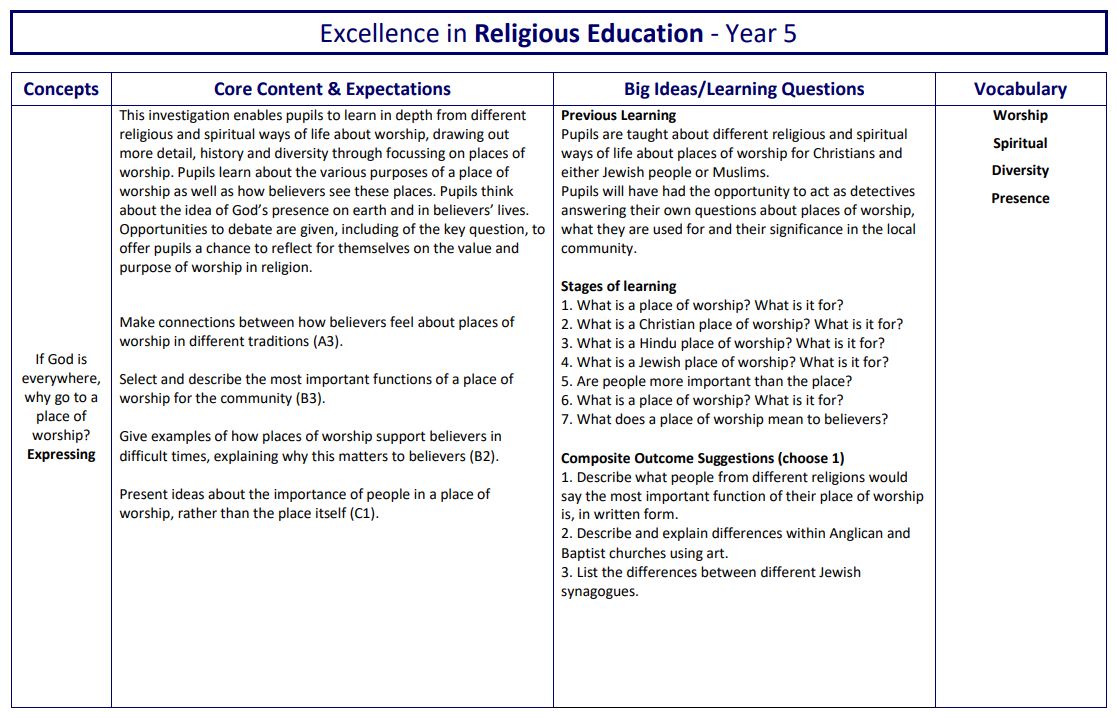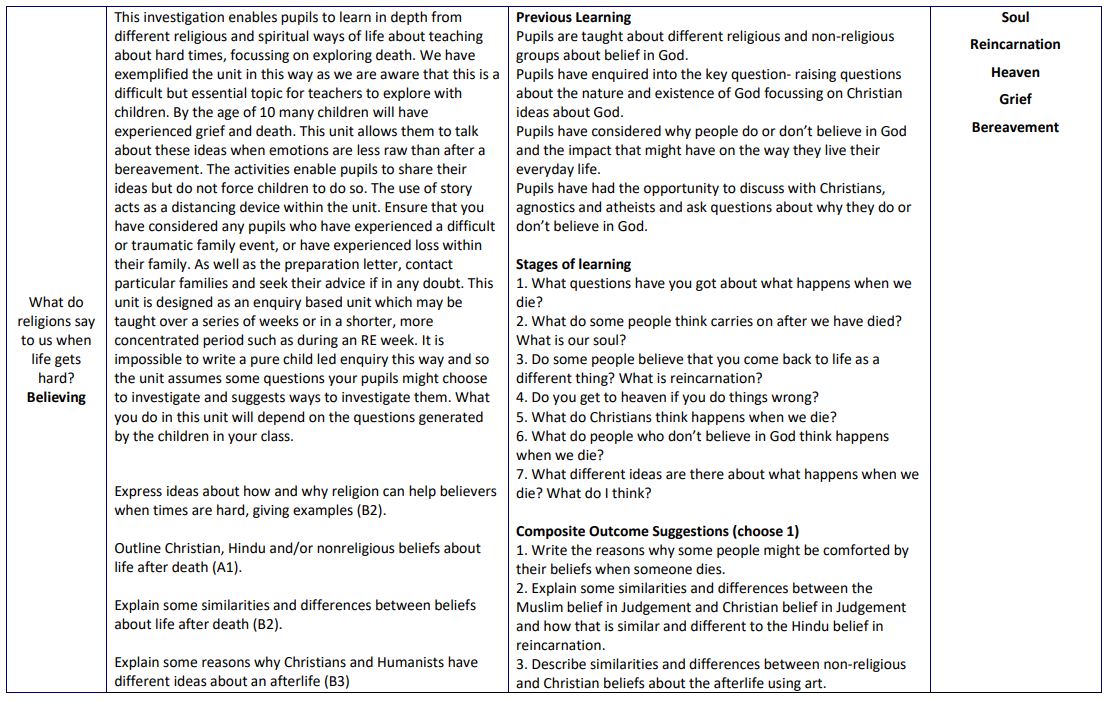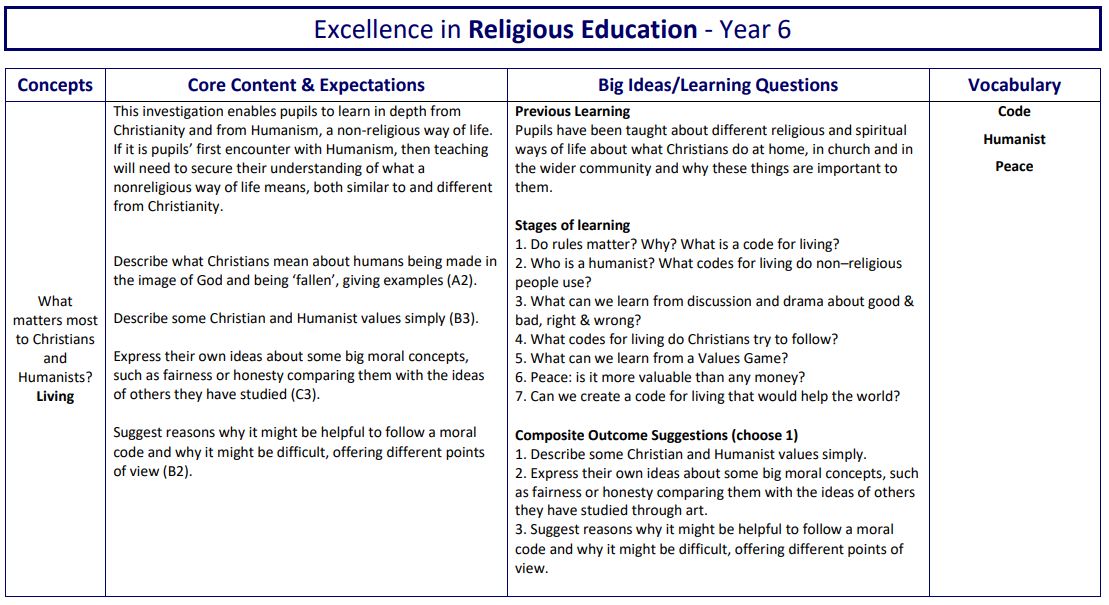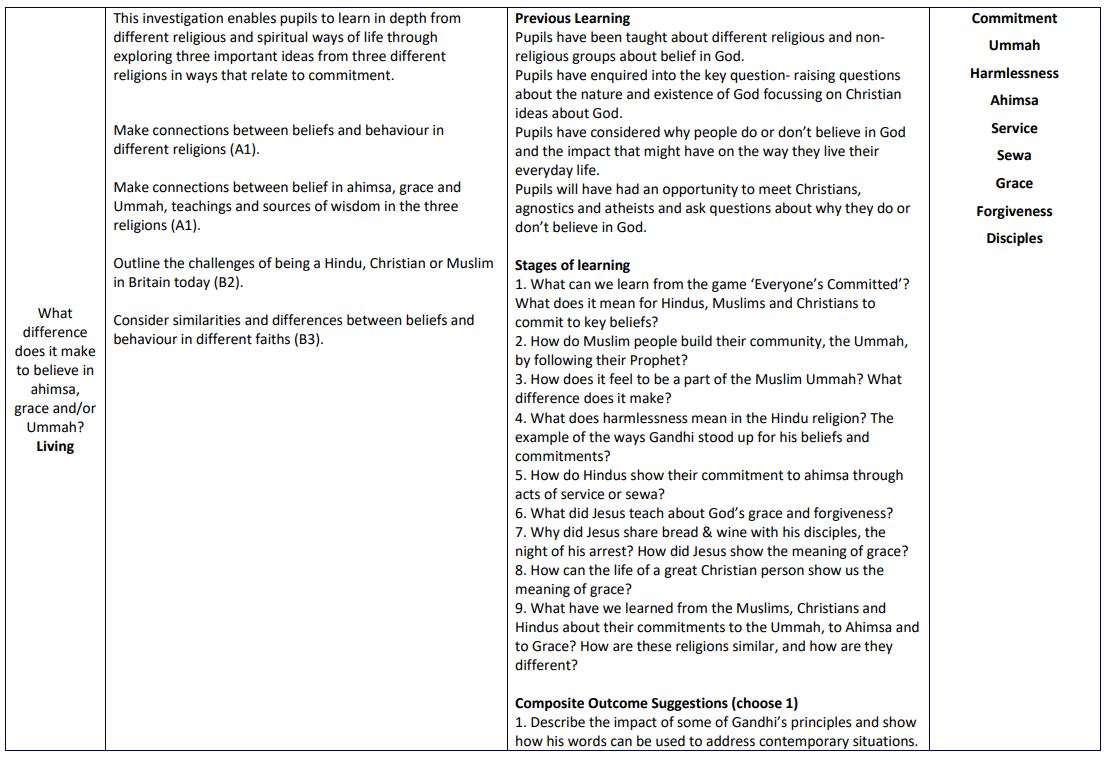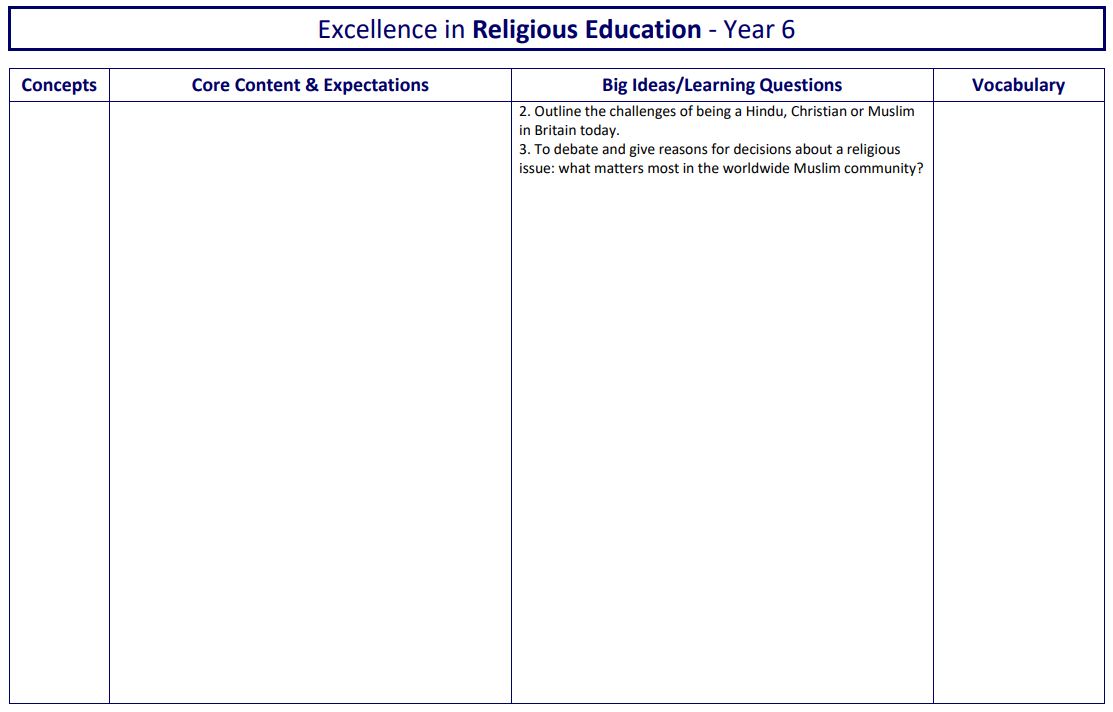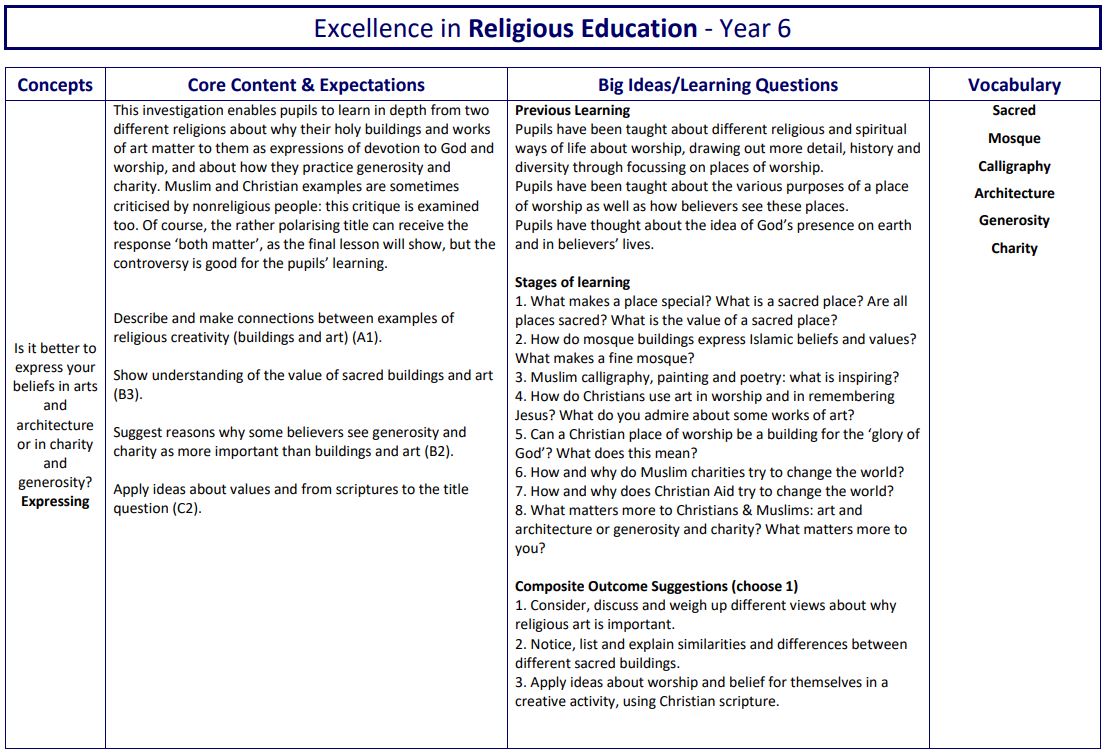Religious Education
Introduction
• concepts specific to a religious tradition (such as the Christian notion of ‘incarnation’)
Implementation
Learning Sequences
We organise intended learning into modules or units. These group the knowledge, skills and understanding that we want children to remember, do and use. Each module aims to activate and build upon prior learning, including from the early years, to ensure better cognition and retention. The units are deliberately spaced within and across years to introduce and revisit key concepts. This enables staff to deepen pupil understanding and embed learning. Each unit is carefully sequenced to enable pupils to purposefully layer learning from previous sessions to facilitate the acquisition and retention of key knowledge.
• CHALLENGE Teachers get the children to interrogate their learning - summarise, explain, compare and contrast. Tools are built into routines to reduce overload and allow for hard thinking. These can be adapted for children based on their individual needs.
SEND Learners
· Pupils with SEND are entitled to think hard. We use structured CHALLENGE FRAMEWORKS to promote hard thinking, drawing on the content, including explain the word connections and sequenced thinking paths.
Impact
• Pupil Book Studies help to evaluate curriculum structures, teaching methods, pupil participation and response through a dialogic model.
• Does learning ‘travel’ with pupils and can they deliberately reuse it in more sophisticated contexts?
Teachers employ a range of strategies both at and after the point of teaching to check the impact of their teaching on the permanence of pupils’ learning. These include: retrieval practice, vocabulary use and application, deliberate practice and rephrasing of taught content, summarising and explaining the learning question from the sequence. Teachers use information from tasks, tests, pupil book studies and other monitoring to support learning by responding to the gap between where pupils are and where they need to be. In lessons, they adapt explanations and examples to address misconceptions and provide additional practice or challenge where required. After lessons or tests, they analyse pupils’ responses to identify shared and individual gaps in learning and misconceptions. Teachers then adjust subsequent planned teaching in response.
We use summative assessment is ‘to provide an accurate shared meaning without becoming the model for every classroom activity’ (Christodolou, 2017). If our curriculum is effective, it will lead to improvements in summative assessments over time. Teacher assessment judgements are against an agreed assessment model (the curriculum). We make summative judgements annually. Teachers record summative judgements on OTrack.
Pupil book study is used as a method to quality assure our curriculum by talking to the children and looking in pupils’ books. We do this after content has been taught to see the extent to which pupils are knowing more, remembering more and able to do more. In preparation, we review the planned content, knowledge and vocabulary, so that conversations with pupils are meaningful and focused on what has been taught. When looking at books, we look at the content and knowledge, teaching sequence and vocabulary. We also consider pupils’ participation and consider the explanations and models used, the tasks the pupils are asked to do, the ability to answer carefully selected questions and retrieve information and the impact of written feedback. We ask careful questions that probe their knowledge, understanding and skills.
The Subject Leader undertakes a range of activities to understand what the curriculum looks like across the school and how well pupils know more, remember more and can do more as a result. In addition to the above tools, they use learning walks, planning reviews and book looks. They use their findings to support teachers to improve how they implement subjects and to make recommendations about the suitability of the intent for their subject. The Subject Leader formally reports on impact of the curriculum termly to the Curriculum Leader, Principal and Governors.
Progression Overview
Within the believing strand children become familiar with the idea that some books are holy books. Children learn stories from and about holy books, including stories about Jesus and Prophet Muhammad. Children are given opportunities to retell the stories in a variety of ways and look at how some religious stories are similar and how they differ. Children to think about people who are special, including themselves, their peers and members of the wider community. They move onto finding out about people who are special in religious communities today. Many religious stories focus on specific people and pupils are given an opportunity to learn some of these, thinking about how particular characters can be described as ‘special’. There is an emphasis on how some characters show the qualities of friendship.
Within the expressing strand children explore a range of special places and find out about some buildings that are special for religious believers. Children learn about at least one place of worship. There is the opportunity to show learning about a holy place through model making and the unit finishes with pupils consolidating all of their learning to create a special place for the whole class. Children think about their own significant times and those times that are special in different religions. Festivals focused on in this unit plan are Christmas, Diwali and Sukkot/Sukkoth. However, teachers may decide to focus on other religious special times depending on their class’ needs.
Within the living strand children think about how each person is unique and valuable and consider religious beliefs about this. It allows children the opportunity to think about groups to which they belong, how some people belong to religious groups and what this means. Children will look at occasions marking belonging from a number of faiths, including welcoming ceremonies from Christianity and Islam and Raksha Bandhan in Hinduism. There is a focus on the natural world. Children are encouraged to experience the nature around them and reflect upon the natural world for themselves. This provides a basis for thinking about how the world was created and understanding that many religious people believe that God designed and created it. The creation story from Genesis is introduced alongside two stories from Islam focusing on care for Allah’s creation.
Our RE curriculum precisely follows the Doncaster Locally Agreed Syllabus, to plan RE lessons in KS1. It is our intention that through studying Religious Education pupils at Sandringham will have the opportunity to engage in systematic enquiry into significant human questions which religion and worldviews address. The Religious Education curriculum is intellectually challenging and personally enriching and focuses on the following 3 key strands: believing, living and expressing.
Within the believing strand pupils in Year 1 begin to understand what Christians believe about God and about Jesus as the Son of God. This unit looks at stories about Jesus and stories that Jesus told. The planning gives opportunity for good links with the English curriculum. Teaching in this unit will help pupils to understand that Christians see God as Father and Creator and Jesus as the Son of God and an inspiration to Christian people. This unit also allow pupils to study prayer and in particular the Lord’s prayer. In Year 2 pupils to learn in depth from Islam, finding out about Muslim ways of life and beliefs, so that pupils can develop thoughtful ideas and viewpoints of their own about some religious and spiritual questions. Pupils find out about sacred books from more than one religion. It clearly builds upon work from unit F1 (Which stories are special and why?). We choose to study the Bible and the Torah or the Bible and the Qur’an rather than looking at all three sacred books.
Within the expressing strand pupils in Year 1 learn about different religious and spiritual ways of life about places of worship for Christians and either Jewish people or Muslims. Within the unit teachers should plan for a visit to the two places of worship being studied if at all possible. Pupils will have the opportunity to act as detectives answering their own questions about places of worship, what they are used for and their significance in the local community. In Year 2 pupils learn about different religious and spiritual ways of life about Easter and Pesach (Passover) and/or Eid-ul- Fitr. Through art, drama and music the significance of these celebrations to believers is explored focussing on story, symbol and particular celebrations.
Within the living strand pupils in Year 1 think about belonging. They will learn about how religious people show they belong to their faith community. They will learn about ways babies are welcomed in religions and the promises made at weddings. They will think about their own network of belonging and how we all belong to someone. In Year 2 pupils will learn about religious and spiritual ways of life about caring for other people and for the world. Through studying Bible stories, the lives of believers such as Dr Barnardo, Mother Teresa or a local believer, the Jewish practice of Tzedakah and Sukkot celebrations pupils learn about how beliefs turn into actions for many religious and non-religious people. The unit encourages creativity through the use of art and music.
Our RE curriculum precisely follows the Doncaster Locally Agreed Syllabus, to plan RE lessons in LKS2. It is our intention that through studying Religious Education pupils at Sandringham will have the opportunity to engage in systematic enquiry into significant human questions which religion and worldviews address. The Religious Education curriculum is intellectually challenging and personally enriching and focuses on the following 3 key strands: believing, living and expressing.
Within the believing strand pupils in Year 3 learn about different religious and spiritual ways of life regarding diverse beliefs about God. In Year 4 pupils learn from Christianity, exploring different reasons why Jesus is considered and inspiring figure by Christians – and by many other people too.
Within the expressing strand pupils in Year 3 learn from different religious and spiritual ways of life as shown through festival and celebration. We have chosen to focus on Easter, Diwali in Hinduism, Pesach in Judaism and Eid ul Fitr in Islam. There are links to literacy, art and philosophy for children within this unit. This unit enables pupils to begin to understand how celebration reminds believers of key beliefs and gives time to focus on beliefs and commitments and celebrating as a believing community. The focus is on the key elements of festival-shared values, story, belief and hopes and commitments. In Year 4 pupils learn from different religious and spiritual ways of life relating to milestones on the journey of life. Through exploring baptism, Bar and Bat Mitzvah or Hindu Samskaras and marriage pupils explore how and why people chose to mark significant moments in life.
Within the living strand pupils in Year 3 learn from different religious and spiritual ways of life about what Christians do at home, in church and in the wider community and why these things are important to them. In Year 4 pupils learn about key aspects of Hindu belief and worship. What we call ‘Hinduism’ is the diverse way of life, spiritual practices and beliefs of the Indian people. We are focussing on British Hindus, and there is great diversity in British Hinduism as well as the original Indian Hinduism. Hinduism is more appropriately called ‘Sanatana Dharma’; eternal truth. We will find out some key Hindu beliefs, and how these are expressed in thoughts and actions. We will also think about being a Hindu in Britain today. Pupils think about guidance that people follow to help them live their lives. It starts off by looking into the Golden Rule and how it is seen in Christianity, Humanism and Judaism. Pupils then look at guidance for living from all three of these worldviews, examining how Christians, Humanists and Jewish people might decide what is ‘right’. The unit moves on to look at teachings about temptation in Christianity and Judaism, helping pupils to think about what religious stories show about temptation. Finally, pupils investigate the life of a religious figure, looking at how teachings from religion may affect the actions of a believer.
Our RE curriculum precisely follows the Doncaster Locally Agreed Syllabus, to plan RE lessons in UKS2. It is our intention that through studying Religious Education pupils at Sandringham will have the opportunity to engage in systematic enquiry into significant human questions which religion and worldviews address. The Religious Education curriculum is intellectually challenging and personally enriching and focuses on the following 3 key strands: believing, living and expressing.
Within the believing strand pupils in Year 5 learn from different religious and non-religious groups about belief in God. Pupils enquire into the key question- raising questions about the nature and existence of God focussing on Christian ideas about God. Pupils will consider why people do or don’t believe in God and the impact that might have on the way they live their everyday life. This investigation provides an opportunity to meet Christians, agnostics and atheists and ask questions about why they do or don’t believe in God. In Year 6 pupils learn from different religious and spiritual ways of life about teaching about hard times, focussing on exploring death. We have exemplified the unit in this way as we are aware that this is a difficult but essential topic for teachers to explore with children. By the age of 10 many children will have experienced grief and death. This unit allows them to talk about these ideas when emotions are less raw than after a bereavement. The activities enable pupils to share their ideas but do not force children to do so. The use of story acts as a distancing device within the unit. This unit is designed as an enquiry-based unit which may be taught over a series of weeks or in a shorter, more concentrated period such as during an RE week. It is impossible to write a pure child led enquiry this way and so the unit assumes some questions your pupils might choose to investigate and suggests ways to investigate them. What you do in this unit will depend on the questions generated by the children in your class.
Within the expressing strand pupils in Year 5 learn from different religious and spiritual ways of life about worship, drawing out more detail, history and diversity through focussing on places of worship. Pupils learn about the various purposes of a place of worship as well as how believers see these places. Pupils think about the idea of God’s presence on earth and in believers’ lives. Opportunities to debate are given, including of the key question, to offer pupils a chance to reflect for themselves on the value and purpose of worship in religion. In Year 6 pupils learn from two different religions about why their holy buildings and works of art matter to them as expressions of devotion to God and worship, and about how they practice generosity and charity. Muslim and Christian examples are sometimes criticised by nonreligious people: this critique is examined too. Of course, the rather polarising title can receive the response ‘both matter’, as the final lesson will show, but the controversy is good for the pupils’ learning.
Within the living strand pupils in Year 5 learn from different religious and spiritual ways of life about being a follower of the Muslim religion. Pupils explore the five pillars of Islam and the importance of these to Muslim believers. Pupils will gain a greater understanding of Islam and what we can learn from its beliefs, values and ideas. This investigation provides an opportunity to learn about the Qur’an and other forms of guidance and visit a Mosque. In Year 6 pupils learn from Christianity and from Humanism, a non-religious way of life. If it is pupils’ first encounter with Humanism, then teaching will need to secure their understanding of what a nonreligious way of life means, both similar to and different from Christianity. Pupils learn from different religious and spiritual ways of life through exploring three important ideas from three different religions in ways that relate to commitment.
